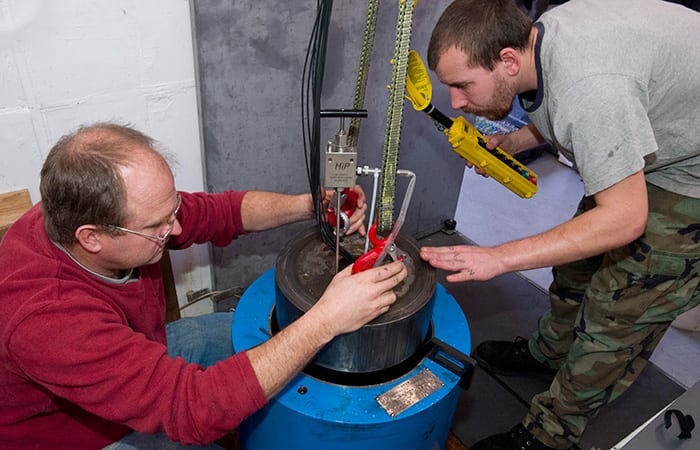
Rebuilding Alvin: Hugh Popenoe and Rob Lewis
A series on the people who reassembled the iconic sub
From the beginning of 2011 to May 2013, Alvin, the U.S. science community’s only human-occupied submersible dedicated to deep-sea research, underwent a thorough overhaul and upgrade to greatly enhance its capabilities. In the end, the iconic sub was redesigned and rebuilt, piece by piece, by a one-of-a-kind team of engineers, technicians, and pilots at WHOI.
Here, engineer Hugh Popenoe and engineer assistant Rob Lewis describe how they tested the penetrators, key components on the redesigned sphere:
Hugh: We’re getting ready to do pressure tests on an optical penetrator. Alvin has 14 electrical penetrators and 6 optical penetrators in the hull.
Rob: Fiber-optic penetrators bring in the fiber-optic lines from outside the sub to the inside. Electrical penetrators are almost the same, except that it’s all electrical wires.
Hugh: All the electronic and optical data is housed outside the sphere, and all that information has to come through these penetrators to the pilot in the sphere. All the commands from the pilot to the thrusters and instruments also travel out through the penetrators. They mount to holes in the personnel sphere.
Rob: The penetrators plug the holes, and that’s why we’re testing, to make sure they don’t leak when they’re at depth.
Hugh: They have to be able to withstand the same pressure as the sphere, at depths down to 6,500 meters, or just over 4 miles. Right now Alvin is being certified to go to 4,500 meters, but in a few years when we try to certify it to go deeper, the penetrators will already be cleared for that depth and we won’t have to re-test them. Each penetrator has two O-ring seals to it. An O-ring leak or structural failure would potentially doom the life of the occupants inside. In the pressure testing, we try to defeat one seal at a time. The idea is that each seal individually can hold that pressure, but there’s a second seal that can also do it. One of the requirements for Alvin is that there’s backup for everything.
Rob: There’s a pressure gauge on the chamber, and when we run the tests, we monitor that to make sure the pressure doesn’t drop.
Hugh: If a seal fails, water would be coming out through the hole in the end cap of the test chamber where the penetrator is mounted.
Rob: We also test the optical fibers and confirm that they’re still working under pressure. We’ve got a light meter that measures the amount of light loss down each fiber.
Hugh: With electrical penetrators, we monitor the functionality of the wires.
Rob: In this picture, I’m controlling the overhead hoist, and we’re lowering the end cap of the test chamber. The fiber-optic lines in the chamber are about 8 meters long. They’re in a tube that hangs down from the penetrator.
Hugh: The chamber is about 4 feet deep.
Rob: We’re spinning the end cap to make the tube coil into the chamber.
Hugh: Then we’ll seal the chamber and pressurize it to 14,700 pounds per square inch. The whole series of tests takes a full day to complete. Fortunately, we didn’t see any failures at all. Every implodable component on the sub had to be pressure-tested to a defined depth, even the cameras and lights. Rob and I spent about four months just testing the penetrators.
Hugh: I just got my 10-year certificate at WHOI. My background is in electrical engineering. I do a lot of different projects, but they’re always a variation of the same thing— data and power for vehicles and instruments.
Rob: I started here in the beginning of November.
Hugh: Really? That’s it?
Rob: Yeah, I’m the new guy. Pretty much thrown right into assembling and testing the penetrators. My background is in electronics. I worked over at the Marine Biological Lab for just shy of 12 years. I’ve done a lot of different things over at MBL, but this is my first time working on a submarine.
Alvin is owned by the U.S. Navy and operated by WHOI. The current upgrade has been funded largely by the National Science Foundation, with support from private donations to WHOI.
From the Series
Related Articles
Featured Researchers
See Also
- Building the Next-Generation Alvin from Oceanus magazine
- Alvin Gets an Interior Re-design from Oceanus magazine
- New Personnel Sphere Passes Pressure Test WHOI News Release
- Alvin's Pilots from Oceanus magazine
- National Deep Submergence Facility
